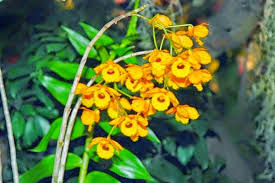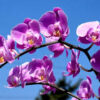# Natural Materials for Growing Dendrobium Orchids: A Comprehensive Guide

Dendrobium orchids, particularly *Dendrobium nobile*, are among the most popular orchids cultivated worldwide. Known for their stunning flowers and relatively straightforward care requirements, these orchids can thrive in various growing media, especially when utilizing natural materials. This article explores the best natural materials for creating a suitable potting mix for Dendrobium orchids, focusing on their benefits, properties, and practical applications.
## 1. Understanding the Growing Requirements of Dendrobium Orchids
### 1.1 Overview of Dendrobium Orchids
Dendrobium orchids belong to the Orchidaceae family, characterized by their distinctive pseudobulbs, long-lasting blooms, and diverse species. They are native to tropical and subtropical regions, primarily found in Southeast Asia and Australia. *Dendrobium nobile* is particularly cherished for its beautiful flowers and is commonly used in traditional medicine and ornamental displays.
### 1.2 Ideal Growing Conditions
To flourish, Dendrobium orchids require:
– **Bright Indirect Light**: These orchids thrive in bright, filtered sunlight, making them perfect for windowsills or areas with dappled light.
– **Temperature and Humidity**: They prefer temperatures between 65°F and 85°F (18°C to 29°C) and humidity levels of 40% to 70%.
– **Well-Draining Medium**: A suitable potting mix is essential for preventing root rot and ensuring healthy growth.
### 1.3 Importance of Potting Medium
The potting medium plays a crucial role in providing stability, moisture retention, and aeration for the roots. Using natural materials can mimic the orchids’ native environments, ensuring optimal growth and vitality.
## 2. Natural Materials for Dendrobium Orchids
Natural materials are often the best choice for potting Dendrobium orchids, as they provide excellent drainage, aeration, and nutrients. Here’s a detailed look at some of the best natural materials to use:
### 2.1 Bark Chips
#### 2.1.1 Types of Bark
– **Fir Bark**: Widely used for orchids due to its excellent drainage and aeration properties. It decomposes slowly, making it ideal for long-term use.
– **Pine Bark**: Another popular choice, pine bark is slightly more acidic and can help maintain the pH balance of the potting medium.
– **Coconut Bark**: Known for its high water retention properties, coconut bark can be mixed with fir or pine bark to create a balanced medium.
#### 2.1.2 Benefits of Bark Chips
– **Aeration**: Bark chips allow air to circulate around the roots, promoting healthy growth.
– **Drainage**: They help prevent water retention, reducing the risk of root rot.
– **Nutrient Content**: As bark decomposes, it releases nutrients beneficial for plant growth.
### 2.2 Sphagnum Moss
#### 2.2.1 Overview of Sphagnum Moss
Sphagnum moss is a natural, fibrous material harvested from wetlands. It is often used in orchid potting mixes due to its unique properties.
#### 2.2.2 Benefits of Sphagnum Moss
– **Moisture Retention**: Sphagnum moss can retain significant amounts of water while still allowing for proper drainage.
– **Acidity Regulation**: It helps maintain an acidic environment, which is beneficial for Dendrobium orchids.
– **Lightweight**: Its lightweight nature makes it easy to handle and mix with other potting materials.
### 2.3 Coconut Coir
#### 2.3.1 Overview of Coconut Coir
Coconut coir is made from the husks of coconuts and is an excellent sustainable alternative to peat moss.
#### 2.3.2 Benefits of Coconut Coir
– **Sustainability**: Coir is a renewable resource, making it an environmentally friendly option.
– **Moisture Management**: Like sphagnum moss, coconut coir retains moisture while allowing for aeration.
– **pH Neutral**: It is generally pH-neutral, providing a balanced growing medium.
### 2.4 Perlite
#### 2.4.1 Overview of Perlite
Perlite is a volcanic glass that has been heated and expanded to create lightweight, porous particles.
#### 2.4.2 Benefits of Perlite
– **Excellent Drainage**: Perlite enhances drainage and aeration, preventing waterlogged conditions.
– **Inert Material**: It does not decompose over time, providing a long-lasting structure for the potting mix.
– **Lightweight**: Its lightweight nature makes it easy to handle and mix with other materials.
### 2.5 Charcoal
#### 2.5.1 Overview of Charcoal
Charcoal, particularly horticultural charcoal, is made from burned organic matter and is often used in orchid potting mixes.
#### 2.5.2 Benefits of Charcoal
– **Odor Absorption**: Charcoal helps absorb odors and impurities, keeping the growing medium fresh.
– **pH Regulation**: It can help maintain a stable pH level in the potting mix.
– **Drainage Enhancement**: Charcoal improves drainage and aeration, preventing root rot.
### 2.6 Tree Fern Fiber
#### 2.6.1 Overview of Tree Fern Fiber
Tree fern fiber is derived from the trunks of certain ferns and is used as a potting medium or as an additive.
#### 2.6.2 Benefits of Tree Fern Fiber
– **Aeration**: Tree fern fiber provides excellent aeration and drainage.
– **Slow Decomposition**: It decomposes slowly, ensuring longevity in the potting mix.
– **Nutrient Retention**: It retains moisture and nutrients, promoting healthy growth.
## 3. Creating a Balanced Potting Mix
### 3.1 Ideal Ratios
Creating a balanced potting mix involves combining various natural materials to achieve optimal drainage, aeration, and moisture retention. A common potting mix for Dendrobium orchids may include:
– **40% Bark Chips**: For aeration and stability.
– **30% Sphagnum Moss or Coconut Coir**: For moisture retention.
– **20% Perlite**: For drainage enhancement.
– **10% Charcoal or Tree Fern Fiber**: For odor absorption and nutrient retention.
### 3.2 Mixing Techniques
To create a balanced potting mix:
1. **Measure the Materials**: Use a scale or measuring cups to ensure accurate ratios.
2. **Combine the Ingredients**: Mix the dry materials thoroughly in a large container.
3. **Moisten the Mix**: Lightly mist the mix with water to help the sphagnum moss or coconut coir absorb moisture.
4. **Test the Texture**: The mix should be light and fluffy, allowing air to circulate while holding moisture.
## 4. Potting and Repotting Dendrobium Orchids
### 4.1 Choosing the Right Pot
Selecting the right pot is essential for the health of your Dendrobium orchids. Key considerations include:
– **Size**: Choose a pot that allows for root expansion without being too large, which can retain excess moisture.
– **Material**: Terra cotta pots are porous and help with drainage, while plastic pots retain moisture longer.
– **Drainage Holes**: Ensure the pot has adequate drainage holes to prevent water accumulation.
### 4.2 Potting Techniques
1. **Remove the Orchid**: Gently take the orchid out of its current pot, taking care not to damage the roots.
2. **Trim Dead Roots**: Inspect the roots and trim any dead or rotting sections with sterilized scissors.
3. **Place in the New Pot**: Position the orchid in the center of the new pot, allowing room for growth.
4. **Fill with Potting Mix**: Gradually add the prepared potting mix around the roots, ensuring there are no air pockets.
5. **Water Thoroughly**: After potting, water the orchid thoroughly to help settle the mix and provide moisture to the roots.
### 4.3 Repotting Frequency
Dendrobium orchids should be repotted every 1-2 years, or when the potting medium breaks down or the plant outgrows its pot. Signs that repotting is needed include:
– **Decomposed Medium**: If the potting mix appears broken down or compacted.
– **Root Bound**: When roots are visible through the drainage holes or circling the pot.
## 5. Care and Maintenance of Dendrobium Orchids
### 5.1 Watering
Proper watering is crucial for the health of Dendrobium orchids. Key tips include:
– **Frequency**: Water when the top inch of the potting mix feels dry.
– **Method**: Water thoroughly until it drains from the bottom, ensuring even moisture distribution.
– **Humidity**: Increase humidity levels around the orchid by using a humidity tray or misting the leaves.
### 5.2 Fertilization
Dendrobium orchids benefit from regular fertilization during the growing season. Tips include:
– **Fertilizer Type**: Use a balanced, water-soluble orchid fertilizer diluted to half strength.
– **Frequency**: Fertilize every 2-4 weeks during the growing season and reduce during dormancy.
### 5.3 Light and Temperature
Providing adequate light and temperature is essential for healthy growth:
– **Light**: Place orchids in bright, indirect light, avoiding direct sunlight, which can scorch the leaves.
– **Temperature**: Maintain temperatures between 65°F and 85°F (18°C to 29°C) for
optimal growth.
### 5.4 Pest and Disease Management
Monitoring for pests and diseases is vital to maintaining healthy Dendrobium orchids. Common issues include:
– **Pests**: Watch for aphids, scale, and mealybugs. Treat infestations promptly with insecticidal soap or neem oil.
– **Diseases**: Root rot can occur from overwatering or poorly draining media. Ensure proper drainage and reduce watering if symptoms appear.
## 6. Conclusion
Utilizing natural materials for growing Dendrobium orchids creates a suitable and thriving environment for these beautiful plants. By understanding the properties and benefits of various natural materials, growers can craft an optimal potting mix that promotes healthy growth and vibrant blooms. Regular care, proper potting techniques, and an understanding of the orchid’s needs will lead to successful cultivation and the enjoyment of these stunning plants in any home or garden. Embracing the beauty and diversity of Dendrobium orchids not only enriches our spaces but also deepens our connection to the natural world.

